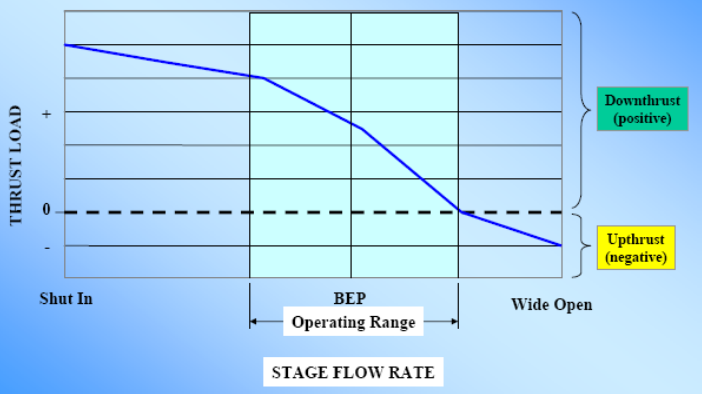There are mainly two designs of electrical submersible pump stages widely used by ESP’s service companies:
- Fixed impeller or compression pump design: every impeller is fixed to the shaft and is not free to move up and down. Hence, it cannot move without the shaft moving. All the impellers are “compressed” together to make one rigid body.
- Floating stage design: each impeller in a floater pump is free to move up and down on the shaft within the confines of the diffuser as depicted in the following Figure. The thrust washers on the impeller support the stage thrust. The amount of thrust varies with liquid rate (the amount of fluid being pumped).

Compression Pump:
In a compression pump, all the impellers are rigidly fixed to the shaft. Therefore, if an impeller wants to move up or down, it will take the shaft with it.
The impellers are located so that they are running with a clearance to the diffuser above and below it. Consequently, the impeller thrust (FI) is transferred to the pump shaft. The seal section thrust bearing has to carry the total thrust (Total thrust = Impeller thrust + Shaft thrust). This is why a high load bearing may be required in the seal section.
The impeller is normally sitting down on its lower diffuser during assembly due to gravity. Because of this, the pump shaft is “raised” with shims in the coupling so that the impeller is not allowed to touch the diffuser after final assembly. This allows all thrust developed in the pump shaft to be transferred to the protector shaft directly.
Pump shimming: There is a small amount of free play in the coupling such that the pump shaft can fall down to where the impellers ride directly on the lower diffusers or on the downthrust washers if available.

 Why use Compression Pumps?
Why use Compression Pumps?
- Some stages generate too much thrust to be handled by a thrust washer in the stage.
- Some fluids (e.g. liquid propane) do not have enough lubricity to properly lubricate a thrust washer.
- If abrasives or corrosives are present, it may be beneficial to handle the thrust in an area lubricated by motor oil rather than well fluid.
- Occasionally in very gassy wells, the flow volume changes so drastically within the pump that parts of a floater pump could be in very severe thrust while others are not so a compression pump could be one alternative.
- Since all the thrust is handled in the protector, as long as the protector has a great enough capacity, the pump operating range can be extended over a much wider area without any increased wear or reduced life.
Floater Pumps:
Since a floating impeller is free to move up and down the shaft, the only thing to stop it is either the upper or lower diffuser. “Thrust washers” are provided at all mating surfaces between the impeller and diffuser to absorb any thrust generated.
The stage carries and absorbs the impeller thrust. The thrust is transferred through the thrust washers to the diffuser to the housing. Therefore, the seal section only sees the shaft thrust.
NB: One misconception is that the impeller floats between the diffuser thrust surfaces at the optimum flow rate. When the impeller reaches or nears its balanced thrust point, it will become unstable and begin to oscillate up and down. Therefore, they are designed to be stable in slight downthrust at their optimum design flow rate and to pass through this transition region at a higher flow rate. A typical centrifugal pump thrust.

Why Use “Floater” Pumps?
- Since each stage handles its own thrust, a very large number of stages can be put in a pump without having to worry about protector bearing capacity.
- Floaters are also very good with mild abrasives since they prevent material from getting into the radial bearing area.
- Floaters are much more forgiving in manufacturing since tolerance stack-up is not a concern.
- Easier field assembly – no shimming required.






very good information,
very usefull informations,
how I get the detail dimention of impeller and difusher.
I realy need detail dimention make by own self, I want to produce old oilwell in my around, there are 615 or more old oilwell.
any one can help me
best regard
Ramelan
east java Indonesia
very good information,
very usefull informations,
how I get the detail dimention of impeller and difusher.
I realy need detail dimention make by own self, I want to produce old oilwell in my around, there are 615 or more old oilwell.
any one can help me
best regard
Ramelan
east java Indonesia